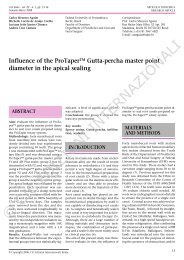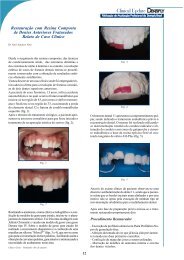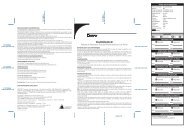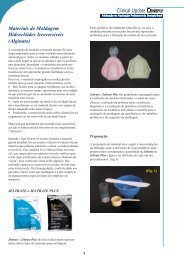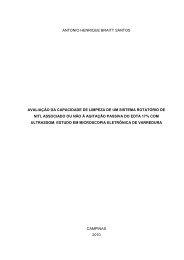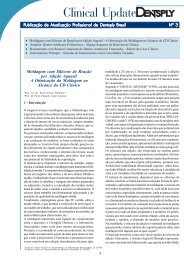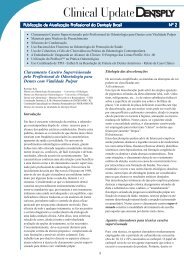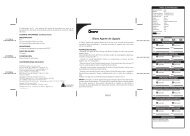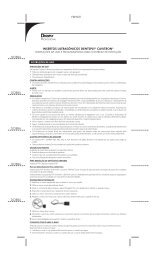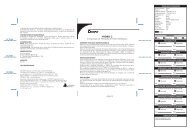Create successful ePaper yourself
Turn your PDF publications into a flip-book with our unique Google optimized e-Paper software.
van Dijken et al<br />
Fig 1 Relative cumulative loss rates<br />
(%) of the Xeno III bonding system in<br />
combination with the two restorative<br />
materials (Tetric Ceram, Dyract AP).<br />
vical lesions. The hypothesis tested was that the polyacid<br />
resin-modified resin composite would show better clinical retention.<br />
MATERIALS AND METHODS<br />
A total of 133 Class V restorations were placed in 57 patients<br />
(32 men and 25 women) with a mean age of 61.5 years<br />
(range 43 to 84), for whom treatment of noncarious cervical<br />
lesions was indicated. All restorations were placed in dentin<br />
lesions without any intentional enamel involvement, by one<br />
experienced operator familiar with adhesive dentistry. Fortyfour<br />
restorations were placed in anterior teeth, 55 in premolars<br />
and 32 in molars. Fifty-nine restorations were made<br />
in the maxillary arch and 74 in the mandibular. A single-step<br />
self-etching primer (Xeno III, <strong>Dentsply</strong>/DeTrey; Konstanz,<br />
Germany; lot nr 0206001237) was evaluated in combination<br />
with two different restorative resinous materials, a hybrid<br />
resin composite (Tetric Ceram, Ivoclar/Vivadent;<br />
Schaan, Liechtenstein; lot E17820) and a polyacid-modified<br />
resin composite (Dyract AP, <strong>Dentsply</strong>/DeTrey; batch nr<br />
0203001190). Liquid A of the two-part adhesive system<br />
contains water, ethanol, HEMA, UDMA and BHT (2,6-di-tertbutyl-p<br />
hydroxyl toluene) and nanofiller. Liquid B contains<br />
UDMA, CQ, EPD (p-dimethylaminoethyl benzoate) and two<br />
patented monomers Pyro-EMA (tetramethacryloxyethyl pyrophosphate<br />
and PEM-F (pentamethacryloxyethyl cyclophosphazene<br />
monofluoride).<br />
The operative field was isolated with cotton rolls and a<br />
saliva suction device. Before conditioning, the lesions were<br />
cleaned of plaque and/or saliva if necessary. The adjacent<br />
gingiva was retracted by gingival retraction instruments or<br />
matrix bands when necessary to secure unrestricted contamination-free<br />
access to the field. No bevel was placed. Application<br />
of the primer was performed according to the manufacturers’<br />
instructions. After mixing, the primer was applied<br />
for 20 s, carefully air dried for some seconds to remove<br />
the solvent, taking care not to thin the primer layer. The layer<br />
was then light cured for at least 10 s (Astralis 7, HP curing<br />
mode; Ivoclar/Vivadent). Sixty-five restorations were<br />
made at random with the polyacid resin-modified resin composite<br />
and 68 with a high-viscosity resin composite restorative<br />
material. The restoratives were applied in most cases in<br />
two increments using selected composite instruments (Hu<br />
Friedy; Leimen, Germany) and light cured. All participants<br />
were informed about the material and the follow-up evaluations<br />
according to the rules at the Dental School Umeå. The<br />
restorations were evaluated at 6, 12, 18, and 24 months using<br />
slightly modified USPHS criteria. 3,5 Only the retention<br />
evaluations are reported here. Postoperative sensitivity was<br />
registered. Descriptive statistics were used to present the results.<br />
Cumulative retention failures were calculated by dividing<br />
the number of lost restorations at the recalls by the<br />
total number evaluated at the respective recall. Differences<br />
in distribution of the ratings between the adhesive systems<br />
for the investigated variables were statistically analyzed with<br />
the binomial test for independent samples and intraindividual<br />
comparisons of the 2 materials with Friedman’s two-way<br />
analysis of variance. 13<br />
RESULTS<br />
At the end of the follow-up, 130 restorations could be evaluated.<br />
One patient with three restorations was not able to attend<br />
the 2-year recall. No recurrent caries was observed or<br />
postoperative sensitivity reported. Ten lost restorations<br />
(7.7%) were observed during the 2-year follow-up, resulting<br />
in relative cumulative failure frequencies for all restorations<br />
at 6, 12, 18, and 24 months of 0.8%, 3.1%, 6.9%, and 7.7%,<br />
respectively. The failure frequencies for the restorations with<br />
Tetric Ceram at the four evaluations were 0%, 0%, 5.9%, and<br />
7.4%, and for Dyract AP restorations 1.6%, 6.5%, 8.1%, and<br />
8.1%, respectively; the differences were not statistically significant<br />
(Fig 1).<br />
242 The Journal of Adhesive Dentistry



